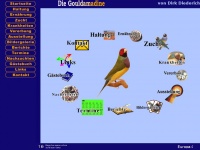Teilnahmeregeln Weltmeisterschaft
Hier nun die Teilnahmeregeln und das Handbuch für die Teilnahme an der 1. Online-Weltmeisterschaft.
Teilnahmeregeln und Handbuch
Die Bewertung erfolgt nach dem niederländischen Standard des NBvV, welchen Ihr unter folgendem Link findet: https://www.nbvv.nl/wp-content/uploads/gouldamadine-2017-2021.pdf
Angewendeter Standard der Weltmeisterschaft

Bewertungskriterien
The Assessment Sections (summary)
A. Size, Model, Attitude, Condition, and plumage (30 points)
Size: The standard prescribes a minimum size of 11 cm, measured between the tip of the beak and the tip of the tail, not counting the extended tail feathers.
Model: This is the „type“ and depends on, among other things, the posture of the Gouldian Finch. The Gouldian Finch must be robust, with a backline of 45 – 60 degrees from the horizonal line.
Attitude: A Gouldian Finch is a calm bird by nature. However, we cannot demand that the Gouldian Finch be displayed like e.g. the budgerigar. We must also take this into account when assessing the attitude. If posture is adversely affected by the position of the legs, this is also assessed under attitude.
Condition: Good physical condition is a prerequisite. Dirty feathering are penalized.
Plumage: A Gouldian finch naturally has a tightly worn plumage.
Furthermore, here the completeness of the feathering is assessed. Male extended tail feathers must be between 25mm – 45mm, and in the Female the extended tail feathers must be between 10mm – 25mm, and the extended tail feathers shall be straight.
B. Size and Shape of the Head and Beak (10 points)
Head: The head shape plays a fairly important role in the Gouldian finch’s assessment. It is important to pay attention to a full, round head. A flat head can be very disturbing. The head shall be nicely proportionate to the body.
Beak: The color of the beak is not assessed in this section but in the color section. In the section beak we only assess the horn part. Beak shall be free of deformities. The shape of the beak is also very important. The bill should be cone-shaped and blend into the head shape. Large and pointed beaks should be punished as well as overgrowths of the lower and upper beak.
C. Legs (5 points)
We also assess the color of the legs in the color section. First, the legs must be clean. Attention should be paid to scaling and roughening of the legs. Birds with missing nails or toes are no longer inspected. Long nails and unnaturally curved nails are also assessed in this section, as well as the position of the toes. In case of serious deviations, these birds may no longer be inspected.
D. Color regularity and intensity (Scale 1: 20 points, Scale 2: 55 points)
Here the body color and the color of the horn part are judged.
A yellow spot on the neck of the green birds is wrong. The aim should be to have the most even grass-green color in the neck as even as possible. Naturally, we must also pay attention to this yellow spot in other mutations. In the blue series, this spot will of course not be yellow but gray to white.
The color of the beak is also assessed in this section. The beak color is slate gray to black in brood-ready females; this should not be penalized. A black beak color in the males should be considered a fault. An orange-red border under the breast patch should also be penalized for color.
In the white-breasted Gouldian finch, a blue haze on the edge of the wing bends may not be penalized. This is usually the result of the white breast feather covering the green, so that the blue structure present in the breast feather will show itself. A blue haze in the wings must of course be penalized.
E. Drawings and Markings (Scale 1: 35 points, Scale 2: 0 points)
A Gouldian finch naturally has many drawing fields, so that the most points can be obtained in this section. The drawing fields must be clearly visible and well defined.
Mask: In the Red-headed and Orange-headed Gouldian Finches, the mask extends from the beak plant to the crown, extends behind the eye and the entire cheek area. It is delimited by the headband and the throat spot. In the black-headed Gouldian finch the mask, the headband and the throat spot form one whole. The mask must be tightly lined and one- colored, without color nuances.
Headband: The red-headed and orange-headed Gouldian finches have a narrow headband, closed at least 1 to max. 2 mm around the mask. This headband should be taut in shape, forming one whole with the throat spot. The headband should not have a recess towards the eye.
Throat patch: The throat patch runs sharply outlined below the cheeks from the inset of the lower beak and is there one whole with the head band.
Throat band: The mask and throat patch are surrounded by a single-colored band called chin and transition zone, respectively. The chin strap, located between the throat spot and the chest, should be narrow in shape and sharply separated from that patch of the throat and the chest. The transition zone is located on the rear head; this is tightly delimited at the front by the headband. At the rear, it gradually merges into the feather fields of the neck.
Chest: The chest patch extends from the throat band to a line running from wing bend to wing bend, where there is a sharp separation of color from the lower breast. The breast color must be single-colored without color nuances.
Rump and uppertail coverts: The feathering of the rump and uppertail coverts has a border at the end, creating a regular scale pattern.
Tail feathers: The non-extended tail feathers have a narrow border at the end, tapering to the outside of the feather.




